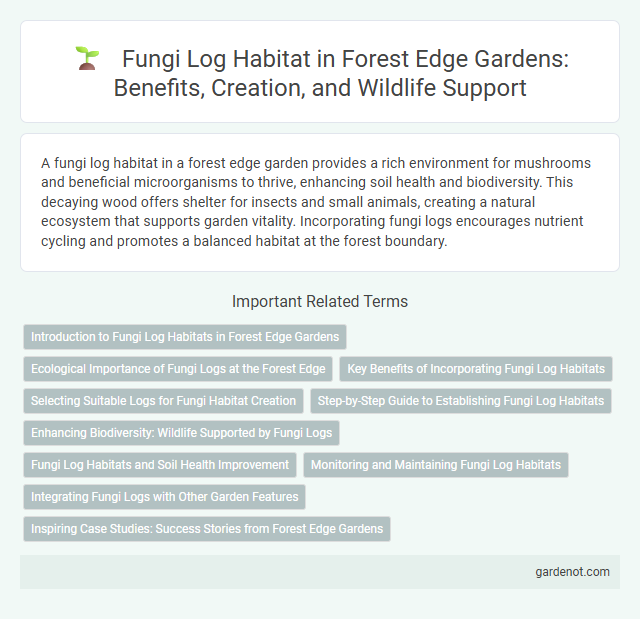A fungi log habitat in a forest edge garden provides a rich environment for mushrooms and beneficial microorganisms to thrive, enhancing soil health and biodiversity. This decaying wood offers shelter for insects and small animals, creating a natural ecosystem that supports garden vitality. Incorporating fungi logs encourages nutrient cycling and promotes a balanced habitat at the forest boundary.
Introduction to Fungi Log Habitats in Forest Edge Gardens
Fungi log habitats in forest edge gardens play a crucial role in supporting biodiversity by providing a decomposing substrate for various fungi species, which in turn enriches soil health. These logs create microhabitats that sustain saprobic and mycorrhizal fungi essential for nutrient cycling and plant growth. Incorporating fungi logs enhances ecosystem resilience by fostering symbiotic relationships with native flora and improving forest edge garden sustainability.
Ecological Importance of Fungi Logs at the Forest Edge
Fungi logs at the forest edge play a crucial role in nutrient cycling by decomposing organic matter and releasing essential minerals back into the soil, supporting plant growth and biodiversity. These logs provide habitat and food sources for a variety of insects, fungi, and microorganisms, fostering a complex ecological network. Their presence enhances soil structure and moisture retention, promoting ecosystem resilience and stability in transitional zones between forest and open land.
Key Benefits of Incorporating Fungi Log Habitats
Fungi log habitats enhance forest edge gardens by promoting nutrient cycling and improving soil health through fungal decomposition of organic matter. These logs provide essential microhabitats for beneficial insects and microorganisms, fostering biodiversity and supporting ecosystem resilience. Incorporating fungi logs also aids moisture retention, which benefits surrounding plant growth and helps maintain stable garden conditions.
Selecting Suitable Logs for Fungi Habitat Creation
Selecting suitable logs for fungi habitat creation involves choosing decaying hardwood species like oak, maple, or birch, which provide essential nutrients for fungal growth. Logs should be free from pesticides, positioned in shaded, moist areas to maintain optimal humidity, and sized between 3 to 6 feet in length and 8 to 12 inches in diameter for effective colonization. Proper selection enhances biodiversity and supports beneficial fungi that contribute to forest edge garden ecosystem health.
Step-by-Step Guide to Establishing Fungi Log Habitats
Establishing fungi log habitats begins with selecting freshly fallen hardwood logs, preferably oak or maple, which retain moisture and nutrients essential for fungal growth. Drill holes into the log at regular intervals, then insert mushroom spawn plugs or sawdust spawn to inoculate the wood effectively. Position the logs in shaded, humid areas near the forest edge garden to maintain optimal moisture levels and promote a thriving fungal ecosystem.
Enhancing Biodiversity: Wildlife Supported by Fungi Logs
Fungi logs create vital microhabitats that support a diverse range of wildlife, including insects, amphibians, and small mammals. Decomposing wood enriched by fungal growth provides essential nutrients and shelter, fostering complex food webs and promoting ecological balance. This natural process enhances biodiversity by sustaining species that rely on decaying organic matter for survival within the forest edge garden.
Fungi Log Habitats and Soil Health Improvement
Fungi log habitats play a crucial role in forest edge gardens by decomposing organic matter and recycling nutrients, which significantly enhances soil fertility. These logs provide a rich environment for beneficial mycorrhizal fungi that form symbiotic relationships with plant roots, improving water retention and nutrient absorption. The presence of fungi logs promotes biodiversity, supports soil microbial communities, and contributes to long-term soil health improvement and ecosystem stability.
Monitoring and Maintaining Fungi Log Habitats
Regular monitoring of fungi log habitats involves inspecting moisture levels, temperature, and fungal growth stages to ensure optimal conditions for diverse fungal species. Maintaining these habitats requires managing decaying wood by repositioning logs to retain moisture, removing competing vegetation, and preventing excessive disturbance. Effective fungi log habitat management supports biodiversity by fostering mycelial networks critical for nutrient cycling and forest ecosystem health.
Integrating Fungi Logs with Other Garden Features
Fungi logs create a vital habitat that enhances soil health and biodiversity by decomposing organic matter and cycling nutrients. Integrating fungi logs with garden features like native plant beds and shaded pathways fosters symbiotic relationships, promoting fungal growth and supporting beneficial insects. Positioning logs near compost areas or water sources further amplifies their ecological benefits by maintaining moisture and encouraging mycelium networks.
Inspiring Case Studies: Success Stories from Forest Edge Gardens
Fungi log habitats in forest edge gardens have proven vital for enhancing biodiversity and soil health, as demonstrated by numerous success stories. In several inspiring case studies, decomposing logs inoculated with native fungal species significantly increased mycorrhizal networks, improving nutrient cycling and plant growth. These forest edge gardens show that integrating fungi logs creates resilient ecosystems supporting diverse flora and fauna while promoting sustainable garden management.
Fungi log habitat Infographic

 gardenot.com
gardenot.com